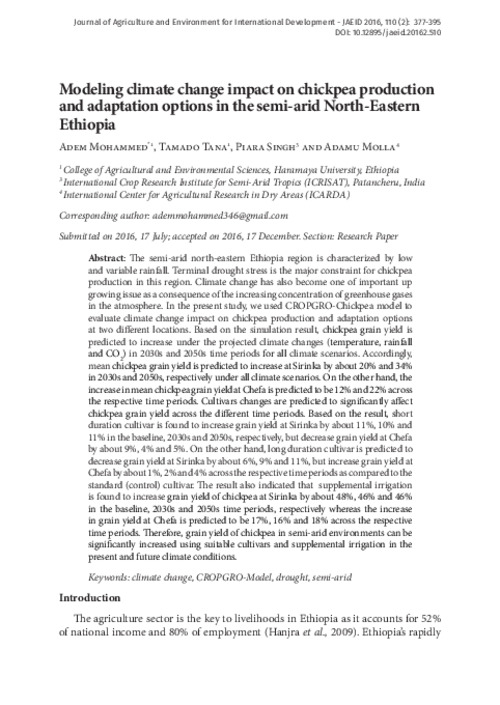Modeling climate change impact on chickpea production and adaptation options in the semi-arid North-Eastern Ethiopia
Abstract
The semi-arid north-eastern Ethiopia region is characterized by low and variable rainfall. Terminal drought stress is the major constraint for chickpea production in this region. Climate change has also become one of important up growing issue as a consequence of the increasing concentration of greenhouse gases in the atmosphere. In the present study, we used CROPGRO-Chickpea model to evaluate climate change impact on chickpea production and adaptation options at two different locations. Based on the simulation result, chickpea grain yield is predicted to increase under the projected climate changes (temperature, rainfall and CO2) in 2030s and 2050s time periods for all climate scenarios. Accordingly, mean chickpea grain yield is predicted to increase at Sirinka by about 20% and 34% in 2030s and 2050s, respectively under all climate scenarios. On the other hand, the increase in mean chickpea grain yield at Chefa is predicted to be 12% and 22% across the respective time periods. Cultivars changes are predicted to significantly affect chickpea grain yield across the different time periods. Based on the result, short duration cultivar is found to increase grain yield at Sirinka by about 11%, 10% and 11% in the baseline, 2030s and 2050s, respectively, but decrease grain yield at Chefa by about 9%, 4% and 5%. On the other hand, long duration cultivar is predicted to decrease grain yield at Sirinka by about 6%, 9% and 11%, but increase grain yield at Chefa by about 1%, 2% and 4% across the respective time periods as compared to the standard (control) cultivar. The result also indicated that supplemental irrigation is found to increase grain yield of chickpea at Sirinka by about 48%, 46% and 46% in the baseline, 2030s and 2050s time periods, respectively whereas the increase in grain yield at Chefa is predicted to be 17%, 16% and 18% across the respective time periods. Therefore, grain yield of chickpea in semi-arid environments can be significantly increased using suitable cultivars and supplemental irrigation in the present and future climate conditions

